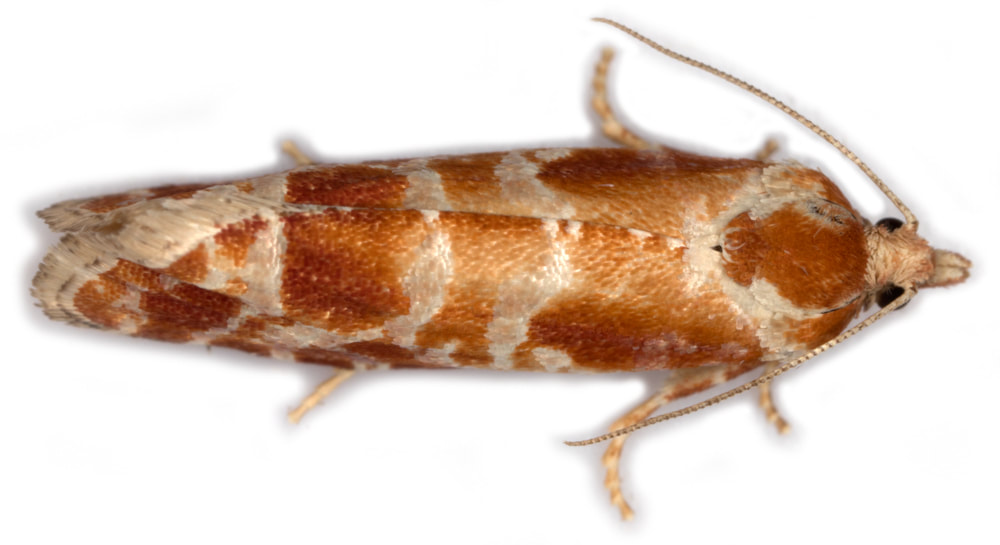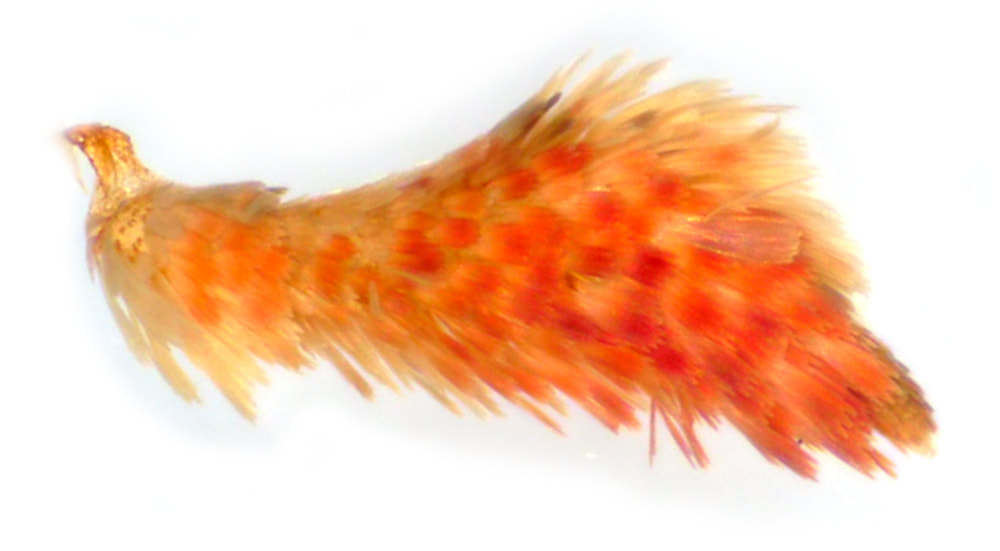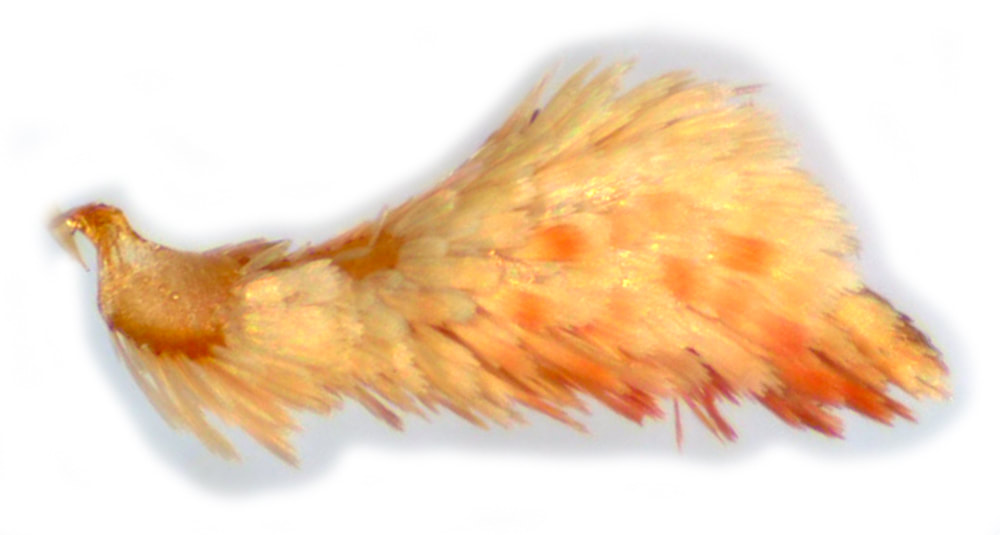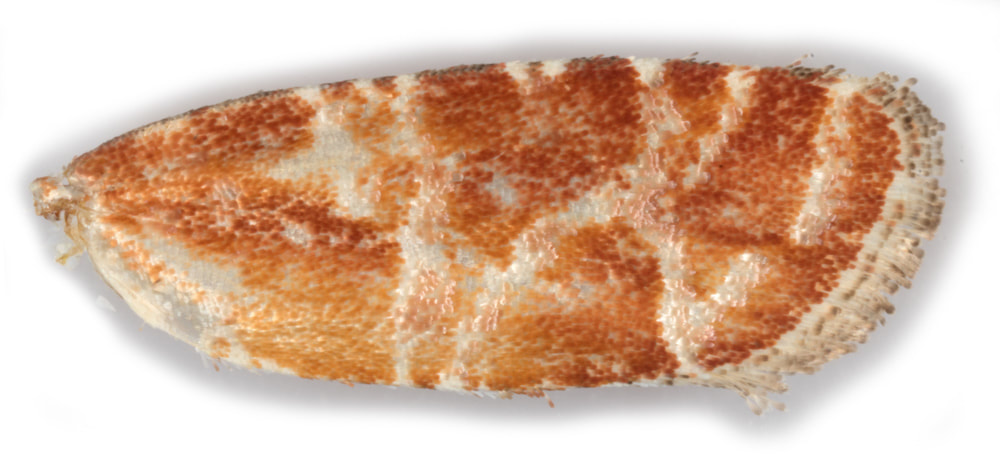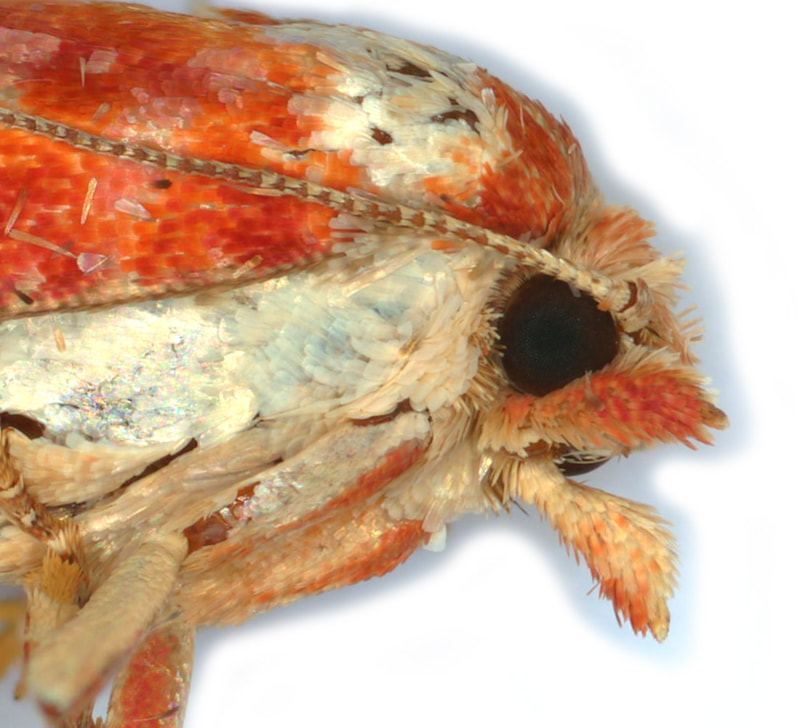49.306 Rhyacionia pinicolana (Smooth Pine Shoot Moth)
ws: 16-23mm; Jul-Aug; Scots pine (Pinus sylvestris); common in pine woodland and areas with scattered pines in England
ID: Similar to R.buoliana but differs in: 1) costa straighter in R.buoliana; 2) pre-tornal marking with a triangular apex or continued into a fasciate marking in R.buoliana, with a more rounded apex in R.pinicolana; 3) the silvery stria immediately distal to the pretornal mark is uninterrupted across the width of the forewing in R.buoliana, more interrupted in R.pinicolana; 4) ground colour of forewing is orange in R.buoliana, orange-red (duller) in R.pinicolana; 5) hindwing fuscous (darker) in R.buoliana, grey (paler) in R.pinicolana; 6) prominent posterior thoracic crest in R.buoliana, indistinct crest in R.pinicolana.
Male genitalia: 7) In R.pinicolana the ventral margin of the valva is strongly emarginate at the neck with a distinct protruding hump at the proximal end of the emargination; in R.buoliana the emargination is shallower and the hump less produced. 8) The neck of valva is much shorter in R.buoliana with only a very narrow gap between distal margin of basal cavity and cucullar spines. 9) The apex of the tegumen (uncus is rudimentary) is slightly pointed in R.pinicolana, slightly notched in R.buoliana.
According to Pierce & Metcalfe: In R.pinicolana the aedeagus is long, ending in two points, without cornuti; that of R.buoliana ends in one point and has 4 cornuti - the difference with respect to the apex but not with respect to the cornuti are apparent (but not very obvious) from the images at Moth Dissection, the illustrations in MBGBI5.2 and my specimens.
Female genitalia: 10) Sclerotisation at the posterior end of the ductus bursae is in a single long section (longer then the anal papillae) in R.pinicolana; shorter and in 2 sections (together shorter than the anal papillae) in R.buoliana. 11) The corpus bursae has 2 small signa in R.pinicolana, no signa in R.buoliana.
Male genitalia: 7) In R.pinicolana the ventral margin of the valva is strongly emarginate at the neck with a distinct protruding hump at the proximal end of the emargination; in R.buoliana the emargination is shallower and the hump less produced. 8) The neck of valva is much shorter in R.buoliana with only a very narrow gap between distal margin of basal cavity and cucullar spines. 9) The apex of the tegumen (uncus is rudimentary) is slightly pointed in R.pinicolana, slightly notched in R.buoliana.
According to Pierce & Metcalfe: In R.pinicolana the aedeagus is long, ending in two points, without cornuti; that of R.buoliana ends in one point and has 4 cornuti - the difference with respect to the apex but not with respect to the cornuti are apparent (but not very obvious) from the images at Moth Dissection, the illustrations in MBGBI5.2 and my specimens.
Female genitalia: 10) Sclerotisation at the posterior end of the ductus bursae is in a single long section (longer then the anal papillae) in R.pinicolana; shorter and in 2 sections (together shorter than the anal papillae) in R.buoliana. 11) The corpus bursae has 2 small signa in R.pinicolana, no signa in R.buoliana.
§1 Westcliff-on-sea, Essex; 05/08/2008; female; fw 9.5mm
§2 Arnside, Cumbria; 26/07/2013; male; fw 9.4mm
§3 New Forest, Hampshire; 14/08/2018; female; fw 9.3mm; to light
§4 Cranwich Heath, Norfolk; 05/07/2018; male; fw 9.1mm
§5 Orlestone Forest, Kent; 11/07/2018; female; fw 9.9mm
§6 Westcliff-on-sea, Essex; 03/07/2022
All images © Chris Lewis
§2 Arnside, Cumbria; 26/07/2013; male; fw 9.4mm
§3 New Forest, Hampshire; 14/08/2018; female; fw 9.3mm; to light
§4 Cranwich Heath, Norfolk; 05/07/2018; male; fw 9.1mm
§5 Orlestone Forest, Kent; 11/07/2018; female; fw 9.9mm
§6 Westcliff-on-sea, Essex; 03/07/2022
All images © Chris Lewis
Page published 29/01/2013 (§1) | §2 added and male genital text added 07/12/2013 | text amended 21/08/2016 | §3 added 19/02/2019 |
§4 added 30/04/2019 | §5 added 20/05/2019 | §6 added 27/11/2022
§4 added 30/04/2019 | §5 added 20/05/2019 | §6 added 27/11/2022


